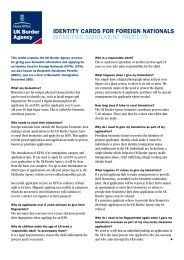Inspiring New Zealanders on Every Screen - Tvnz
Inspiring New Zealanders on Every Screen - Tvnz
Inspiring New Zealanders on Every Screen - Tvnz
- No tags were found...
Create successful ePaper yourself
Turn your PDF publications into a flip-book with our unique Google optimized e-Paper software.
40 / TVNZ ANNUAL REPORT FY2009Notes to the Financial Statements (c<strong>on</strong>tinued)For the year ended 30 June 2009s) Employee benefitsProvisi<strong>on</strong> is made for employee benefits accumulated as a result of employees rendering services up to balance date. The benefitsinclude wages and salaries, incentives, compensated absences and retirement leave which are expensed in the income statement whenservices are provided or benefits vest with the employee. The provisi<strong>on</strong> for employee benefits is stated at the present value of theestimated future cash outflows to be incurred resulting from employees’ services provided up to balance date.t) Provisi<strong>on</strong>sProvisi<strong>on</strong>s are recognised when the Group has present legal or c<strong>on</strong>structive obligati<strong>on</strong> as a result of a past event that can be estimatedreliably, and it is probable that an outflow of ec<strong>on</strong>omic benefits will be required to settle the obligati<strong>on</strong>.If the effect of time value of m<strong>on</strong>ey is material, provisi<strong>on</strong>s are determined by discounting the expected future cash flows at a pre-taxrate that reflects current market assessments of the time value of m<strong>on</strong>ey and the risks specific to the liability.u) <str<strong>on</strong>g>New</str<strong>on</strong>g> accounting standards and interpretati<strong>on</strong>sStandards and Interpretati<strong>on</strong>s that have recently been issued or amended but are not yet effective have not been adopted by the Groupfor the annual reporting period ending 30 June 2009. These are noted below.NZ IFRS 8 – Operating SegmentsReplaces NZ IAS 14 Segment Reporting, the new standard requires a management approach to segment reporting. NZ IFRS 8 isa disclosure standard so will not have a direct impact <strong>on</strong> the amounts included in the Group’s financial statements. However theamendments may have an impact <strong>on</strong> the Group’s segment disclosures. The applicati<strong>on</strong> date for this standard is for accounting periodsbeginning <strong>on</strong> or after 1 January 2009, the applicati<strong>on</strong> date for the Group for this standard is 1 July 2009.NZ IAS 1 (revised) – Presentati<strong>on</strong> of Financial StatementsThe revised standard introduces a statement of comprehensive income. Other revisi<strong>on</strong>s include changes to the presentati<strong>on</strong> of itemsin the statement of changes in equity, new presentati<strong>on</strong> requirements for restatements or reclassificati<strong>on</strong>s of items in the financialstatements, changes in the presentati<strong>on</strong> requirements for dividends and changes to the titles of financial statements. The amendmentsare expected to <strong>on</strong>ly affect the presentati<strong>on</strong> of the Group’s financial statements and will not have a direct impact <strong>on</strong> the measurementand recogniti<strong>on</strong> of amounts under the current NZ IAS 1. The Group has not determined at this stage whether to present the newstatement of comprehensive income as a single or two statements. The applicati<strong>on</strong> date for this standard is for accounting periodsbeginning <strong>on</strong> or after 1 January 2009, the applicati<strong>on</strong> date for the Group for this standard is 1 July 2009.NZ IFRS 7 (amended) – Financial Instrument: DisclosuresThe amended NZ IFRS requires fair value measurements to be disclosed by the source of inputs using a three level hierarchy. NZ IFRS 7is a disclosure standard so will not have a direct impact <strong>on</strong> the Group’s financial statements. The applicati<strong>on</strong> date for this standard is foraccounting periods beginning <strong>on</strong> or after 1 January 2009, the applicati<strong>on</strong> date for the Group for this standard is 1 July 2009.NZ IAS 23 (revised) – Borrowing CostsThe amendments to NZ IAS 23 require that all borrowing costs associated with a qualifying asset must be capitalised. The Group mayhave qualifying assets which will require borrowing costs to be capitalised. The applicati<strong>on</strong> date for this standard is for accountingperiods beginning <strong>on</strong> or after 1 January 2009, the applicati<strong>on</strong> date for the Group for this standard is 1 July 2009.3) Significant accounting judgements, estimates and assumpti<strong>on</strong>sThe preparati<strong>on</strong> of the financial statements requires management to make judgements, estimates and assumpti<strong>on</strong>s that affect thereported amounts in the financial statements. Estimates and assumpti<strong>on</strong>s are reviewed by management <strong>on</strong> an <strong>on</strong>going basis. Actualresults may differ from these estimates.Management has identified the following accounting policies for which significant judgements, estimates and assumpti<strong>on</strong>s are made:Estimati<strong>on</strong> of useful lives of property, plant and equipment and finite-lived intangible assetsThe estimated useful life of a particular asset is based <strong>on</strong> historical experience, the expected service potential of the assets andtechnological advances. Adjustments to useful lives are made when c<strong>on</strong>sidered necessary.Income taxes and deferred taxThe Group’s accounting policy for taxati<strong>on</strong> requires management to make estimates as to, am<strong>on</strong>gst other things, the amount of tax thatwill be payable, the availability of losses to be carried forward and the recovery of deferred tax assets.Deferred tax assets are recognised for deductible temporary differences as management c<strong>on</strong>siders that it is probable that future taxableprofits will be available to utilise those temporary differences.Capitalised development costsDevelopment costs are <strong>on</strong>ly capitalised by the Group when it can be dem<strong>on</strong>strated that the technical feasibility of completing theintangible asset is valid so that the asset will be available for use.Actual results may differ from these estimates as a result of reassessment by management or taxati<strong>on</strong> authorities.
















